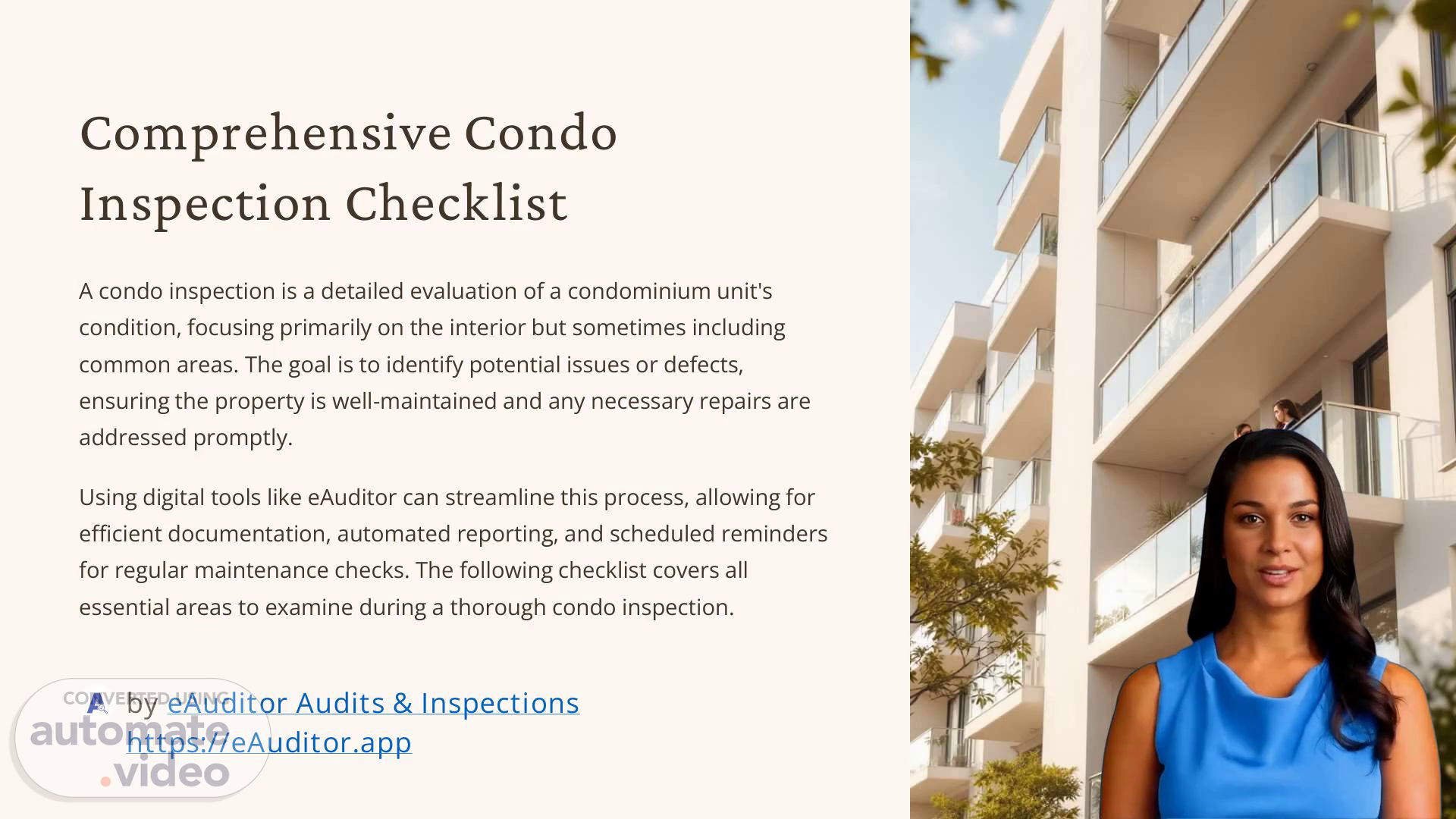Scene 1 (0s)
[Virtual Presenter] The condo inspection is a detailed evaluation of a condominium unit's condition, focusing primarily on the interior but sometimes including common areas. Its purpose is to identify potential issues or defects, ensuring the property is well-maintained and any necessary repairs are addressed promptly. With digital tools such as eAuditor, this process can be streamlined, enabling efficient documentation, automated reporting, and scheduled reminders for regular maintenance checks. The comprehensive checklist covers all essential areas to examine during a thorough condo inspection..
Scene 2 (35s)
[Audio] The inspector should record the necessary general information, which includes their name, date and time of inspection, condo unit number, owner or tenant name, and current weather conditions. Next, the inspector will assess the front door, examining its condition, frame, and functionality, testing the locks, handles, and doorbell to ensure they are working properly. The inspector will also verify the condition and functionality of all lighting fixtures in the entryway, checking for any exposed wiring that could pose a safety hazard. Finally, the inspector will inspect the flooring condition, looking for any damage, excessive wear, or maintenance issues..
Scene 3 (1m 14s)
[Audio] When conducting a living room evaluation, it's essential to thoroughly inspect all walls and ceilings for cracks, stains, or water damage. Note any areas where paint is peeling, bubbling, or otherwise compromised. Check window glass for cracks or chips, and test all seals and locks to ensure proper functionality. Examine flooring for scratches, stains, or uneven areas, and look for wear patterns, stains, or odors on carpets. Test all electrical outlets and switches to confirm proper function. Pay special attention to corners and areas near windows where moisture problems often first appear. Verify that windows open and close smoothly without excessive force, and check for any exposed wiring, loose outlets, or unusual warmth from electrical fixtures..
Scene 4 (1m 59s)
[Audio] In this kitchen section, we must carefully examine the cabinets and drawers, checking their alignment, wear, and functionality. We should also test the water pressure, drainage, and functionality of the sink and plumbing system, while searching for signs of water damage or pests. Moreover, we need to verify the functionality of appliances like the stove, oven, refrigerator, microwave, and dishwasher. Lastly, we must inspect the countertops for scratches, stains, cracks, and overall cleanliness..
Scene 5 (2m 30s)
[Audio] In this bedroom assessment, we will examine the walls and ceilings for any signs of damage or neglect. We will look for cracks, stains, or water damage, and take note of any areas that may require touch-ups or repairs. We will also check the paint condition throughout the room, making sure it's even and well-maintained. Next, we will inspect the windows, examining the glass, seals, and locks for any signs of wear or damage. We will check for drafts or condensation between panes, ensuring that all windows open, close, and lock properly. Finally, we will pay special attention to exterior walls, where insulation issues might be present. By doing so, we will identify any potential problems early on and address them accordingly..
Scene 6 (3m 16s)
[Audio] Bathrooms are particularly vulnerable to moisture-related issues. Carefully check all plumbing connections for signs of leaks or corrosion. Test water pressure in sinks and showers, and verify that drains empty promptly without gurgling. Examine the area around the toilet base for any signs of leaking or seal failure. Inspect ventilation fans to ensure they're working properly, as inadequate ventilation can lead to mold and mildew problems. Check all caulking around tubs, showers, and sinks for deterioration or mold growth..
Scene 7 (3m 47s)
[Audio] The laundry area should be inspected for its condition and functionality. Leaks, unusual noises, and proper ventilation should be checked. Dryer vents should also be ensured to be clean and unobstructed. The heating and cooling system should be tested by checking filters, vents, and thermostat operation. Unusual noises during operation and proper airflow should be inspected. Balcony or patio's flooring should be examined for cracks or damage, railing's stability and condition should be checked, and outdoor lighting fixtures should be tested. Smoke and carbon monoxide detectors should be tested, fire extinguishers should be checked for expiration and proper placement, and emergency exits should be verified to be accessible..
Scene 8 (4m 30s)
[Audio] By using eAuditor, we can efficiently document our findings by creating a digital template that organizes sections logically. We can add checkboxes, text fields, and even attach photos where necessary to accurately capture the conditions we've observed. With this digital documentation, we can automate the generation of detailed reports at the conclusion of each inspection. These reports can then be instantly shared with property owners, tenants, or management companies, providing transparency and clarity throughout the entire process. Furthermore, we can set up recurring inspection schedules and automated reminders within eAuditor, ensuring that regular maintenance checks are performed in a timely manner. This proactive approach helps prevent small issues from escalating into major problems, ultimately saving time and resources in the long run..
